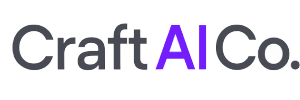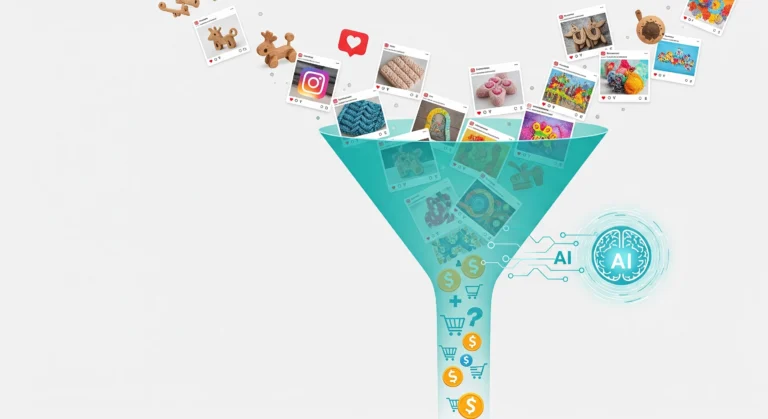Numerous studies show that independent crafters and small business owners often struggle with the overwhelming task of pricing their handmade products appropriately, risking either underpricing themselves or selling at a loss. Worse, manual pricing becomes exponentially more difficult when scaling up, leading to inconsistent or inadequate profit margins.
This critical strategic oversight can cripple even the most talented artisans. Pricing Strategy AI, seamlessly integrated into solutions like Craftaico, offers a revolutionary approach to eliminate guesswork and centralize your valuation process.
The right intelligent tool can transform your pricing system, making it dynamic, data-driven, and aligned with market conditions, thereby turning the often-detrimental challenge of pricing into a strategic advantage that attracts the right buyers and guarantees profitability.
The Strategic Toolkit
Addressing the complexities of handmade product pricing requires more than just a calculator—it demands a holistic system combining strategic insights, accessible tools, and expert guidance. Building a robust pricing framework involves assembling the right elements:
Strategic Foundation: Market Understanding and Goals
Effective pricing starts with deeper than gut feelings. Before diving into software, establish key fundamentals: know your target audience intimately—what do they value most? Determine your business goals—are you focused on market penetration, sustainability, or maximizing revenue per unit? Learn more about defining your strategy here. Understanding competitor pricing dynamics and your unique value proposition is essential to formulating a profitable pricing strategy. Your manual method only gets you so far, and subjective decision-making can lead to missed opportunities or lost sales. AI tools need these strategic inputs to provide truly accurate and meaningful recommendations, transforming your pricing function into a proactive strategic asset rather than a reactive necessity.
Essential AI-Powered Tools for pricing strategy AI
Leveraging the right technology simplifies complex calculations and analysis. Here are a few widely recognized AI-driven solutions tailored for artisan and handmade product pricing:
Price2Fit: Visit the Price2Fit homepage to explore their AI algorithms that learn from your sales data and market trends to optimize pricing automatically, creating personalized pricing recommendations based on your specific business model. This tool significantly reduces the time spent updating prices across channels and seasons, freeing you to focus on product development and customer relationships. The AI component takes the guesswork out of factor pricing models.
Agorapulse: This platform’s Agorapulse Pricing module uses AI to monitor competitor pricing across thousands of websites globally. Check out Agorapulse’s features here. It provides automated alerts for competitor price changes and suggests optimal repricing to stay competitive, directly feeding into a data-centric pricing strategy AI. Integrations help maintain consistency across sales channels. It’s an external link to the homepage, offering a broader view of the AI landscape beyond a single provider. Human oversight is important to interpret these recommendations within your specific brand and product context.
Keep pricing tools: While not an entirely distinct solution, most modern inventory and e-commerce platforms are integrating basic pricing features powered by AI (e.g., Shopify’s dynamic pricing features or similar Magento 2 pricing rules). These tools can apply simple percentage or tier-based pricing automatically, offering a starting point before escalating to sophisticated AI platforms dedicated entirely to pricing strategy AI. The key is understanding the level of sophistication and available customization they offer.
Remember: No tool operates in a vacuum. Human Expertise is crucial to guide AI. A pricing strategy AI requires inputting accurate data, setting clear rules, and interpreting a tool’s output. [Find resources on combining AI with business intuition at Craftaico](https://www.craftaico.com/blog/ integrating-ai-with-artistic-judgment). You set the strategic direction, the AI tool provides the data-driven execution paths. Stay informed about all leading platforms to ensure your pricing decisions are based on the most current competitive landscape and market demand.
Time & Resource Investment: Manual vs. AI-Powered
The sheer time and intellectual resources required for manual pricing can be a significant drain, especially for those managing multiple product lines or operating as solopreneurs:
The Manual Pricing Nightmare
Beyond the initial calculation of costs (materials, labor, overhead), manual pricing involves researching competitor prices, considering market fluctuations, evaluating your brand positioning, and finally, determining a price point that covers costs and yields a desired profit margin. Depending on your production volume or product complexity, this process can take hours, even days, per product revision or seasonal update. For instance, a small batch candle maker with 20 SKUs might spend 5 hours per month manually updating prices thinking strategically about their offerings, before market shifts could alter optimal margins unexpectedly. Recurring costs and manufacturing changes further complicate manual re-pricing. This constant, reactive labor is inefficient and leaves little room for strategic innovation or business growth. In essence, manual pricing is a reactive strategy, dependent on finite human effort and prone to errors over time.
The AI-Powered Advantage
Implementing an AI-driven pricing strategy AI system dramatically shifts the workload. Once integrated correctly, AI tools handle ongoing analysis and recalibration automatically. Inputting your foundational data—cost structures, competitor benchmarks (if enabled), volume targets—is an intensive initial task, but it pays off quickly. A week spent getting a sophisticated tool operational might save hours over the following weeks, translating into significant time savings even within the first month. Many tools also feature user-friendly calculators for initial cost setup.
| Aspect | Manual Method | Pricing Strategy AI | Time Saved Percentage |
|---|---|---|---|
| Initial Product Cost Setup | High (Detailed spreadsheet work) | Medium (Inputting data once) | 50 – 70%* |
| Competitive Analysis | Time-consuming research | Automated monitoring & reports | 80 – 95%* |
| Seasonal Repricing | Multiple hours per event | Auto-recommendations & adjustments | 90 – 99%* |
| Post-Launch Margin Checks | Significant manual analysis | Continuous AI monitoring & alerts | 100% automation |
*Percentage estimates based on case studies and common pain points reported by crafters and small businesses. This fundamental shift frees up your human capital and strategic attention for other critical business activities—customer engagement, marketing, product innovation, and financial planning. The upfront effort invested is an investment in efficiency and scalability. Thousands of hours saved translate directly back into enhanced profitability and growth potential, as you spend less time on administrative tasks and more time building the business.
Key Insight: See the initial data input as an act of faith in technology. Provide accurate information, define clear rules (min/max margins, channel adjustments, etc.), and the AI becomes your tireless, real-time pricing strategist operating far more efficiently than manual processes ever could. This ongoing cycle of minimal human intervention builds a resilient pricing structure that can adapt faster than the competition.
The Implementation Blueprint
Now, let’s translate this strategic potential into practical action. Here’s a straightforward step-by-step guide to implementing an intelligent pricing strategy AI like the one offered by solutions such as Craftaico. This guide is designed for hygienic, reusable steps.
Step 1: Data Audit & Collection
Gather comprehensive data for each product. List primary material costs, secondary material expenses (packaging, shipping supplies). Accurately estimate labor costs for creating the product, any design effort, and your overhead allocation (like rent, utilities, and marketing share). Understand your minimum required profit margin and average markup for your brand. [Pro-Tip]: Don’t forget the time spent on quality control or artistic inspiration—these elements contribute subtly to your overall cost and perceived value. Use an Excel template or a dedicated app for initial data logging if starting manually, then integrate into a chosen AI tool.
Step 2: Select & Set Up Your Tool
Research and choose an AI platform that aligns with your business size and complexity needs (e.g., Price2Fit, Agorapulse, or the built-in tools in your e-commerce platform). Craftaico offers an intuitive pricing strategy module backed by generative AI. Sign up, set up your account, and link relevant data sources like Shopify, Etsy, or your product catalog.
Step 3: Input Foundational Data
Within your chosen tool’s interface, meticulously enter your cost structure, labor inputs, overhead percentages, and your target profit margins. Link your competitor accounts if using a tool like Agorapulse to actively monitor market prices. This setup phase is crucial for the AI to provide accurate recommendations.
Step 4: Define Pricing Rules
Use the tool’s configuration panel to set your specific rules. Define minimum and maximum price points, channel-specific adjustments (online, craft fair, wholesale), seasonal discounts, bundling options, and minimum order quantities. Ensure these rules align with both your profit goals and your brand positioning.
Step 5: Generate Initial Pricing
Run a pricing report or simulation using the AI tool. Observe the suggested price points based on the data and rules you provided. Analyze these recommendations in the context of your market and strategic goals. Don’t blindly adopt every AI suggestion; the AI provides options, your business acumen determines the final price.
Step 6: Test & Implement
Start by adjusting a small percentage of your product line or testing prices on a secondary, stable sales channel before a primary one (e.g., test on Etsy while keeping a static price on your own website). Monitor reactions using analytics tools. Once confident and validated through testing, apply the optimized prices across your channel.
Step 7: Continuous Monitoring
The job doesn’t end when prices launch. Regularly review the AI dashboard for competitor shifts, sales performance, and profit margin reports. Re-pricing should be an ongoing cycle, adjusted monthly or quarterly, rather than a one-time event. The AI facilitates this constant monitoring.
By following these steps, you move from a time-intensive manual system to a dynamic pricing strategy AI, continuously learning pricing model that instantly adapts.
Measuring Success: KPIs & ROI
To ascertain the effectiveness of your intelligent pricing approach, you need to measure tangible business outcomes. Focus on Key Performance Indicators (KPIs) that directly quantify the impact:
| Business Metric | What It Tells You |
|---|---|
| Average Order Value (AOV) | Measures the average amount customers spend per transaction. An increase indicates successful price points value addition. |
| Profit Margin Percentage (%) | The ratio of profit to total revenue for your product lines. Directly reflects pricing effectiveness minus cost volatility. |
| Customer Acquisition Cost (CAC) | The average cost to obtain a new customer. Improved pricing allows better allocation of marketing budgets, lowering CAC indirectly. |
| Conversion Rate (%) | The percentage of visitors (online or store) who make a purchase. Analyze how price adjustments affect purchase likelihood. |
| Inventory Turnover Ratio | Measures how many times your inventory is sold over a period. Healthy turnover indicates prices effectively move stock. |
AI tools often provide built-in dashboards tracking some of these metrics automatically, particularly AOV, margin percentage, and channel-specific performance. You’ll find detailed ROI insights by correlating pre-implementation costs (your initial time investment) with post-implementation results (increased margins). For instance, if your profit margin improved from 30% to 45%, and your pre-implementation manual time investment was preventing growth, the ROI is overwhelmingly positive. Automated monitoring simplifies this analysis, freeing your focus for strategic interpretation. The results-driven nature of AI tools allows you to directly correlate price adjustments (even subtle ones like dynamic pricing) with specific business outcomes, providing undeniable validation of ROI.
Scaling & Advanced pricing strategy AI
Successfully implementing a profitable pricing strategy AI marks the beginning of a journey to sustained success. To truly maximize returns, consider these forward-thinking expansion paths:
Bundling and Tiered Pricing Optimization: AI can analyze customer purchasing behavior to identify optimal product bundles, increasing perceived value and average revenue per transaction. You can then dynamically adjust these bundles and their constituent items for maximum profit. The AI identifies correlations between complementary products that you might not discover through basic rule-based systems. Test various combinations and price points using A/B testing facilitated by your tool to validate what yields the highest combined profit for your artistic enterprises. Tiered service models (e.g., subscription options or craft classes paired with supplies) can also be optimized using the same approach, creating recurring revenue streams.
Influencer Pricing & Limited Edition Launches: Utilize AI to analyze micro-influencer audiences, competition, and historical trend data. Set dynamic prices for limited-edition artisan products during influencer collaborations or seasonal launches. The AI forecasts demand peaks and adjusts prices accordingly to capture maximum value while preventing stock depletion too early at lower markups. It can even suggest dynamic entry fees for craft fairs or wholesale partners based on expected footfall or market saturation derived from your monitoring tools.
AI-Powered Personalization at Scale(pricing strategy AI): Explore the potential for customized pricing rules based on customer segments identified by your CRM (Customer Relationship Management) system. The AI can learn preferences from past interactions, website behaviors, or purchase histories and suggest tailored offers or slight price differences for specific customer groups. This requires careful implementation to avoid pricing discrimination accusations, but if managed well (e.g., personalized “value bundles” rather than direct price variations), AI allows you to maximize revenue while offering enhanced perceived value to different segments, reflecting increasingly personalized customer interactions.
Strategic Business Applications
The capabilities of intelligent pricing strategy AI apply across diverse business models. Here’s how you can apply these principles specifically:
B2B SaaS (Software as a Service): For a SaaS provider offering project management tools to freelancers and agencies, dynamic pricing based on usage levels could work wonders. The AI would analyze competitor pricing structures, customer tiers, user volume, and churn rates for every micro-segment. This allows B2B SaaS companies to offer the right pricing tiers for different client sizes, value propositions, and relationships (enterprise vs. SMB) while ensuring high margins. Implementing an AI system for B2B SaaS pricing allows for sophisticated cross-selling and upselling based on usage data and predicted churn, driving higher lifetime value. Example tool: Agorapulse for competitive monitoring alongside custom SaaS pricing modules.
E-commerce (Online Retail): A boutique online store selling unique handcrafted jewelry benefits from repricing sitting in an ever-changing competitive landscape. The agorapulse pricing module or similar AI tools automatically adjust prices based on competitor fluctuations while maintaining margins. Analyze website visitor behavior data to understand customer willingness to pay, guiding product descriptions and strategic pricing recommendations for high-margin items. The Jewelry Box offers insights into e-commerce strategies. AI automates the tedious task of staying competitive in online marketplaces like Etsy, Amazon Handmade, or Instagram Shopping.
Digital Agencies & Freelance Design: A freelance graphic design agency could use AI to analyze competitor quotes, time-based work costs, and project complexity before drafting proposals. AI helps avoid undervaluing work by providing data-backed fee recommendations based on niche, skills, client size, and document complexity. Instead of guesswork for each project, the agency ensures consistent, profitable quoting, scales proposals faster, and even identifies higher-value client segments to target. Tools like Yieldify or Price2Fit offer specific features for dynamic pricing on e-commerce, but also work for complex quote scenarios. E.g., an agenceausearch-page might use AI to analyze keywords related to their target audience and tailor their service packages accordingly.
Common Strategic Pitfalls to Avoid
Adopting AI for pricing is powerful, but skipping pitfalls can lead to suboptimal results:
1. Overcomplicating the Rules: While AI needs clear instructions, overly complex rule setups often lead to unintended contradictions or suboptimal suggestions. Less truly is more when guiding an AI system. Start simple and expand based on results.
2. Ignoring Brand Psychology and Market Sentiment: Profitable pricing must align with your brand image and resonate with your audience. An AI suggesting a rock-bottom price might increase volume short-term but damage your reputation if associated with lower quality. Don’t let purely financial numbers override strategic brand positioning. Ensure your AI outputs support your brand story.
3. Relying on Historical Data Blindly: AI learns from your and its inputted data, which might become outdated (e.g., due to shifts in digital marketing effectiveness or a recession). Internal links are here for discussing this, but monitor market shifts and competitor innovations actively, and don’t let the AI get too comfortable with stagnant data without incorporating updated benchmarks. The AI provides recommendations; you set the data sources, and it’s your responsibility to keep them refreshed and relevant with regular review.
4. Neglecting Customer Feedback: Prices are dynamic entities. Ignore what customers (or prospects) say about your pricing—whether it feels fair, affordable, or too high. Use monitoring tools (website chat transcripts, social media mentions) to track customer responses to price points and adjust your overall strategy accordingly. Avoid hiding behind an algorithm if your changes from AI inspections lead to customer dissatisfaction related to value perception.
The most successful implementation blends AI’s data capabilities with your human understanding of audience needs and brand essence, steering clear of purely mechanical decision-making based on outdated or context-blind data.
Building Your Content Engine: Systems & Automation using pricing strategy AI
To make intelligent pricing a sustainable, proactive discipline rather than a project, embed it within a broader “content engine” and automated system. Create a “Pricing Flywheel”:
Integrate your chosen AI tool with your e-commerce platform, order management system, inventory management software (like QuickBooks inventor for your crafts), and CRM (like HubSpot).
Automate recurring tasks:
- Competitor Monitoring: Scheduled automatic scans update your knowledge base. Internal Link 1: Competitor Analysis for Crafts
- Price Alerts: Alerts via email or Slack for competitor changes requiring action. Internal Link 2: Dynamic Pricing Strategies
- Seasonal Adjustment: Use AI rules to automatically adjust prices for seasonal products (e.g., gift items) weeks before or after the relevant date. Internal Link 3: Seasonal Pricing Mastery
Your goal is not just automated calculation, but a system that watches, learns, adjusts, tracks, and reports, enabling smarter decisions faster. You create a system that knows your cost structure, understands your market, monitors your results, and provides recommendations round the clock. This automation frees your strategic energy and encourages long-term growth. It makes pricing less reactive and more strategic, aligning constant market conditions with sustainable profitability and repeatable success.
Where to Go From Here
Integrating an intelligent pricing strategy AI provides a distinct competitive edge. What are your biggest challenges right now? Perhaps calculating costs, keeping prices competitive while maintaining your brand image, or feeling overwhelmed by manual re-pricing tasks? Schedule a personalized consultation to explore how we can customize these solutions for your specific needs. DM us but we encourage you to connect directly with our team.
FAQ Section: Pricing Strategy AI
Q1: How much does using pricing strategy AI cost?
A1: Costs for AI pricing tools vary significantly based on features, volume, and deployment method. Investment typically includes a subscription (monthly/annual) covering user accounts, API calls, and specific AI capabilities like competitor monitoring or price prediction. Cheaper options exist, but these might focus on basic rule-based pricing adjustments or use existing features within other platforms before resorting to dedicated AI tools. Register for a demo using Schedule a Call to get specific information based on your business size and process complexity.
Q2: Can AI really handle niche handmade products?
A2: Absolutely. AI tools aren’t just for mass-produced goods; they can be incredibly powerful for niche artisanship. The key is providing the AI with detailed inputs about unique costs, time investments (rare materials, specialized techniques), and competitor benchmarks within your specific niche (e.g., unique glassware for interior designers). Dedicated tools like Craftaico (or alternatives working for craft sectors) have settings designed to handle artisanal specifics beyond standard features, providing deeper ROI analysis for scarcer, high-margin items. Don’t be intimidated—configure it carefully with your product specifics, and it becomes an expert helper.
Q3: What about data privacy? Is my pricing data secure with AI tools?
A3: Reputable AI pricing companies prioritize data privacy and security, especially when handling financial and potentially sensitive business information. Look for tools with clear terms of service regarding data ownership, how data is stored (ideally encrypted), and whether your raw data is anonymized or kept confidential alongside competing businesses. Ensure they comply with regulations like GDPR. Most modern platforms provide robust privacy controls. Learn more here. Ask directly via Schedule a Call. Trust is paramount; only work with companies maintaining industry-standard security protocols as provided by other authoritative sources.




